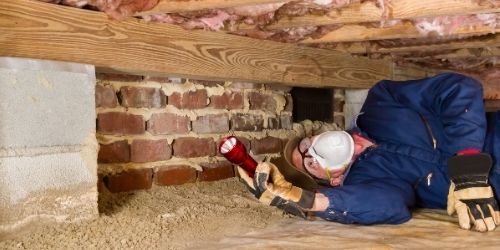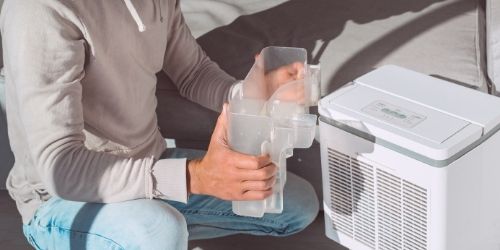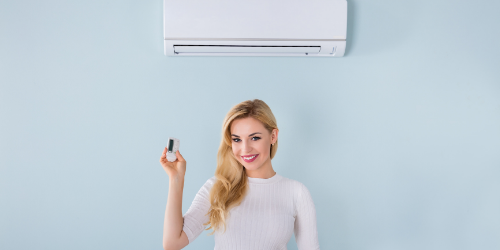Can I use a regular dehumidifier in a crawl space?
3 Key Takeaways:
🚀 Crawl spaces and basements are highly susceptible to water seepage, flooding, and other humidity problems such as mold growth, mildew, condensation, and cracking.
🚀 The root cause of these issues is the basement and crawl space moisture. The solution is to install a dehumidifier specially designed for crawl spaces.
🚀 Regular dehumidifiers are not suitable for use in crawl spaces because their capabilities are insufficient.
Crawl spaces and Basements.
Were you scared of crawlspaces and basements as a child?
We all were. We were horrified to see dark corners, ghosting, and giant spiders on walls.
Little did we know that crawlspace moisture was responsible for all the eeriness. All you needed was a dehumidifier and not an exorcist!
So what’s the difference between a crawl space and a basement?
Basements are floors that are partly or entirely below the ground level in homes.
On the other hand, the crawl space refers to the narrow space between the ground and the ground floor. It is typically 3.2 ft tall in homes. If the crawl space is slightly bigger, from 3 ft 3 inch to 4 ft 11 inch, it doubles as a basement.
Crawlspaces and basements at homes are highly susceptible to water seepage, flooding, and other humidity problems such as mold growth, mildew, condensation, and cracking. The high humidity level is a perfect breeding ground for rodents, insects, wood-eating termites, and carpenter ants.
If the crawl space and basement moisture levels are not contained, they will cause respiratory ailments, allergies, and several other health issues to your family. Even the World Health Organization (WHO) deems that crawl space problems are one of the critical reasons for family health issues.
High moisture levels in the basements and crawl spaces also damage the structural integrity of the whole house. The mold spores, mildew, wall cracks, ghosting, wood rot, and pests from the basement quickly creep all the way up, infesting your entire living area in no time.
Even if you call the best pest control company and home cleaning service, their efforts will only turn futile if you don’t address the issue’s root cause.
Wondering what the root cause is?
It is the basement and crawl space moisture.
How do you address it?
Simple. Install a dehumidifier specially designed for crawl spaces.
Only by using dehumidifiers can you reduce the humidity level to around 55% RH, which is ideal for excellent indoor air quality. Basement and crawl space dehumidifiers help secure the wellbeing of your entire house.
Do I really need a dehumidifier in my crawl space?
Large enough for someone to crawl in, crawl spaces are usually built to elevate the building. But they also house your HVAC system, wiring, plumbing, insulation, and drainage system.
As the International Residential Code (IRC) allows vented and unvented crawl spaces, it is your responsibility to check and eliminate moisture problems.
Most crawlspaces have vents on all the walls. They have a class 1 vapor barrier and foundation vents to aid cross ventilation and air circulation. These vents allow moist air, surface water, and underground water to flow into the crawl space.
On the other hand, if the crawl spaces have no vents or external air circulation, you must make sure that the air is at least conditioned.
This gut scenario affects indoor air quality, causes health hazards, and damages the foundation of your house.
If you would like to live healthily and safely, you need to install a dehumidifier in the crawl space right now.
Regular vs. Crawlspace dehumidifier
When we say dehumidifier, we do not mean any old dehumidifying unit. Installing any home dehumidifying unit will only empty your bank balance and skyrocket your utility bills.
Wondering how a crawl space dehumidifier is different from a regular basement dehumidifier?
Crawl space dehumidifiers have greater dehumidifying intensity, hot air circulation, optimal square feet coverage, energy efficiency, and portability than whole home dehumidification system units.
Its smart digital control panel and auto restart, auto shutoff, and auto defrost features eliminate the need for you to keep visiting the crawl space throughout the day. You can control and monitor the dehumidification system using your smartphone or via Alexa or Google Home systems.
Commercial dehumidifiers are robust and strong enough to dry out standing water, floods, and excess moisture in the air. They can get rid of mold growth and pest problems in no time.
Make sure the crawl space dehumidifier has convenient continuous pump and drainage options to prevent spillage and flooding.
How to keep moisture out of your crawl space?
To keep moisture at bay in your crawl space, you need to create appropriate moisture barriers.
Got no clue about the kind of moisture barriers or dehumidification methods that would be effective?
Here are simple ways to reduce the moisture level in your crawl space. You can deploy a good foundation vent in the crawl space, add some supply air from the HVAC system, or switch on an extra exhaust fan for excellent makeup air.
The supply air method is a good way to dry out the crawl space air. You need to cut a hole in your supply plenum so that the dry and conditioned supply air blows into the crawlspace.
Another method is to lay a vapor barrier in the crawl space floor. The vapor barrier obstructs the water vapor and soil moisture from seeping in.
But the most effective method to keep your moisture problem at bay is by installing a crawl space dehumidifier.
How do I prevent my crawl space from seeping?
Crawl spaces usually have many water seepage issues in the form of puddles, mold problems, pests, and wet, cracked walls. Seepage can be attributed to the following reasons.
✦ Leakage in plumbing or drainage
✦ Surrounding soil water seepage
✦ Condensation

To get rid of the issue, you first need to understand the source of the water leakage. It could be due to surface water, groundwater, plumbing issues, or excess water vapour in the air.
Based on the source, you can employ the water removal methods below.
✦ Seal the cracks
✦ Install a french drain
✦ Deploy a sump pump
✦ Install a crawlspace dehumidifier with a pump
Do I have to run my crawlspace dehumidifier in the winter?
A dehumidifying unit’s water tank collects all the dirt and moisture from the air. If mold develops inside the tank, it will seep into your atmosphere and create greater allergies and respiratory diseases.
First off, just emptying the tank is not enough. You must clean it often to prevent mold growth inside the tank.
Adhere to the steps below for effective tank cleaning.
1. After you empty the tank, fill it will warm water and mild liquid soap.
2. Use a sponge to scrub all the sides and corners.
3. Rinse and spray vinegar solution.
4. Allow it to sit for at least 10 minutes.
5. Wipe, dry, and put it back into the dehumidifier.
Do I have to run my crawlspace dehumidifier in the winter?
Did you know using a cloth dryer, cooking, burning candles, and even growing a Christmas tree in your living room adds to indoor humidity during winter?
You can have a hygrometer handy to keep measuring the RH levels of your indoor spaces and set ideal humidity levels in your dehumidifier. If the relative humidity in your crawl space exceeds 50%, then it’s time to turn on the crawl space dehumidifier. But make sure you use a unit with an auto hot gas defrost feature, or else the dehumidifier coils will suffer from freezing issues.
If your crawl space humidity drops below the ideal level, ensure you switch off the dehumidifier. Or buy a crawl space dehumidifier with auto on and auto off features.
For best results, alternate between heater and dehumidifier to lower crawl area moisture.
FAQ Section
1. How much mold in crawl space is acceptable?
Mold growth in your crawl space is more than an eyesore. It is an indication of a greater looming problem. It has the potential to cause a range of health hazards to your family. It can cause asthma, allergies, coughing, wheezing, nasal congestion, sore throat, eye infections, and skin issues. Prolonged exposure to mold and damp spaces can result in obstructive lung diseases.
Now you don’t need to go into damp crawl spaces to contract these infections. Irrespective of where you are in your home, the mold effect circulates through the air to infect you. That’s how dangerous the crawl space mold is.
Hence not even the tiniest amount of mold on your floor joist or any item is acceptable in your crawl space. Whenever you see mold growth, use remedies such as rubbing alcohol or hydrogen peroxide to destroy it. Or, for more effective results, use the best crawl space dehumidifier.
2. Does a whole home dehumidifier also dehumidify the crawlspace?
If you want to achieve maximum, energy-efficient dehumidification, you must choose dehumidifiers specifically designed for crawl space air. Though a whole home dehumidifier will remove moisture, you might suffer from increased cost and energy utilization.
3. Will a dehumidifier kill existing mold under crawlspace?
Yes, a crawl space dehumidifier can kill any existing mold in crawl areas.
4. Can a dehumidifier be too large for a crawlspace?
Dehumidifiers designed for living rooms, offices, and commercial spaces will have larger sq ft coverage, higher energy consumption, and larger pint capacity. These can be a bit larger for domestic crawl spaces. However, a larger dehumidifier size implies a larger dehumidification capacity.
For example, a 30 pint or 50 pint crawl space dehumidifier can efficiently dehumidify a crawlspace around 1500 sq ft to 2000 sq ft. But if your crawl space is a bit big, you need a 70 pint dehumidifier.
Wrapping Up
Ready for your crawl space dehumidifier installation?
We are sure you are. Remember to read dehumidifier reviews, get customer/ forum member feedback before buying the best dehumidifier for your crawl space.
Happy dehumidifier shopping!

About The Author
Olivia — a self-confessed air quality addict — is a home climate enthusiast, fresh air advocate, and someone with deep personal experience and knowledge about mold extermination. Her work was mentioned in countless notable humidity publications. Previously she was an editor at Mold Remediation.


